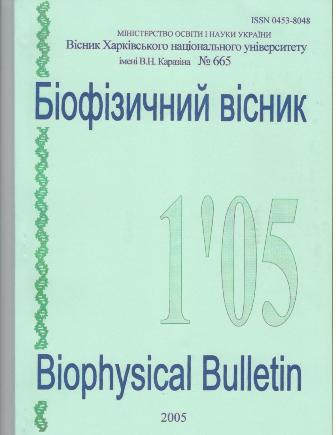Fine structure of amide I BAND OF Fourier ir spectrum of collagen
Abstract
The frequency shifts of the carbonyl vibrations induced by resonance interactions of the carbonyl vibrations for collagen structures (Gly-Pro-Hyp)2-Gly-Phe-Hyp-Gly-Glu-Arg-(Gly-Pro-Hyp)3 and (Pro-Hyp Gly-)3-Ile-Thr-Gly-Ala-Arg-Gly-Leu-Ala-Gly-(Pro-Hyp-Gly)4 have been treated on the basis of molecular exciton theory in a dipole-dipole approximation. Spectral parameters and assignments of elementary components of the fine structure of Amide I Band of Fourier IR spectrum of natural collagen were obtained.
Downloads
References
2. Гришковский Б.А., Хромова Т.Б., Гречишко В.С., Лазарев Ю.А. Формирование гидратной структуры тройной спирали коллагенового типа при гидратации. //Молекулярная биология. 1991. Т. 25, вып. І с. 77-82.
3. Berisio R., Vitagliano L., Mazzarella L., Zagari A. Crystal structure of the collagen triple helix model [(PRO-PRO-GLY)10]3. //Protein Sci. 2002. V. ll. pp. 262-270.
4. Lazarev Yu. A. Chishkovsky B. A., Chromova T. B. Amid I band of IR spectrum and structure of collagen and related polypeptides. //Biopolymers, 1985. V.24. N.7. pp. 1449-1478.
5. Nevskaya N.A., Chirgadze Yu.N. Infrared spectra and resonance interactions of Amide I and II vibrations of a-helix. //Biopolymers. 1976. V. 15. pp. 636-648.
6. Nevskaya N.A., Chirgadze Yu.N. Infrared spectra and resonance interactions of Amide I vibration of the parallel-chain pleated sheet. //Biopolymers. 1976. V. 15. pp. 627-636.
7. Krimm S., Bandakar J. Vibrational spectroscopy and conformation of peptides, polypeptides, and proteins. //Adv. Protein Chem. 1986. V. 38. pp.. 181-364.
8. Мележик Р. П., Семенов М.А. Резонансные взаимодействия карбонильных колебаний в коллагеновых структурах. Е. П. //Біофізичний вісник. 2003. №606. Вип.2 (13). с. 62-68.
9. Воронец Д., Козич Д. Влажный воздух: термодинамические свойства и применение. - М.: Энерго-атомиздат, 1984. - 136 с.
10. Ivanov A.Yu., Plokhotnichenko A.M., Radchenko E.D., Sheina G.G. and Blagoi Yu.P. FTIR spectroscopy of uracil derivatives isolated in Kr, Ar and Ne matrices: matrix effect and Fermi resonance. 11 J. Mol. Struct. 1995. V. 372. pp. 91-100
11. Ivanov A.Yu., Metelkina M.K., Onyshchenko V.V., Blagoi Yu.P. The FTIR spectra and structures of Poly(rA)* Poly(rU)- Mg2' complexes at different temperatures in D2() solutions. //Бioфізичний вісник № 637. Вип. 1-2(14). c. 16-23.
12. Kramer R.Z., Bella J., Mayville P., Brodsky B., Berman H.M. Sequence dependent conformational varia¬tions of collagen triple-helical structure. //Nature Structural Biology. 1999.
V. 6. N. 5. pp. 454-457.
13. Emsley J., Knight C.G., Farndale R.W., Barnes M.J., Liddington R.C. Structural basis of collagen recogni¬tion by integrin a2bl //Cell. 2000. V. 100. pp. 47-56.
14. Элиот А. Инфракрасные спектры и структура полимеров. - М.: Мир, 1972.
15. Miyazawa T.J. Perturbation treatment of the characteristic vibrations of polypeptide chains in various con-figurations II J. Chem. Phys. 1960. V.32. pp. 1647-1652.
16. Чиргадзе Ю.Н. Инфракрасная спектроскопия полимеров и белков. //Итоги науки и техники. Молеку¬лярная биология. Т.1. Москва 1973.
17. Krimm S and Abe Y. Intermodular interaction effects in the Amide I vibrations of β polypeptides. //Proc. Nat. Acad. Sci. The USA. 1972. V.69. N.10. pp. 2788-2792.
18. Чиргадзе Ю.Н., Невская Н.А. Резонансные взаимодействия основных амидных колебаний в упорядо¬ченных пептидных структурах. //Докл. АН СССР. 1973. Т.208. №2. с. 447-450.
19. Давыдов А.С. Теория поглощения света в молекулярных кристаллах. - Киев, изд-во АН УССР, 1951.
20. Семенов М.А., Больбух Т.В. Резонансные взаимодействия карбонильных колебаний в спиральных полипептидах. Препринт № 190, изд-во ИРЭ АН УССР, Харьков, 1982, с. 28.
21. Грибов Л.А. Теория инфракрасных спектров полимеров. - М.: Наука, 1977.
22. Semenov M.A., Bereznyak E.G. Hydration and stability of nucleic acids in the condensed state. //Comments Mol. Cel. Biophys, 2000. V.10. N. l. pp. 1 -23.
23. Eraser R.D.B., Suzuki E. Resolution of overlapping bands: functions for simulating band shapes //Anal.Chem. 1969. V. 1. pp. 37-41.
24. Химмельблау Д. Прикладное нелинейное программирование. - М.: Мир, 1975. - 534 с.
25. Semenov M.A., Starikov E.B. On infrared spectroscopic analysis of transfer RNA secondary structure //Studia biophysica. 1987. V. 120. N. 2. pp. 187-196
26. Veis A. Brownell A.G. Triple-helix formation on ribosome-bound nascent chains of procollagen: Deute¬rium-hydrogen exchange studies. //Proc. Natl. Acad. Sci. The USA. 1977. V. 74. N. 3. pp. 902-905.
27. Chirgadze Y.N., Fedorov O.V., Trushina N.P. Estimation of amino acid residue side-chain absorption in the infrared spectra of protein solutions in heavy water //Biopolymers. 1975. V. 14. pp. 679-694.
28. Frank S. Parker. Applications of infrared, Raman, and resonance Raman spectroscopy in biochemistry. -New York: Plenum press. - 1983. - 550 p.
29. Chien J.C.W. Solid-state characterization of the structure and property of collagen.
II J. Macromol Sci Rev Macrob Chem. 1972. V. 1. pp. 49-104.
30. Heimburg T., Esmann M., Marsh D. Characterization of the secondary structure and assembly of the trans-membrane domains of trypsinized Na, K-ATPase by Fourier transform infrared spectroscopy. //The Journal of Biological Chemistry. 1997. V. 272. N. 41. pp. 25685-25692.
31. Brauner J.W., Flach C.R., Mendelsohn R.A. Quantitative reconstruction of the Amide 1 contour in the 1R spectra of globular proteins: from structure to spectrum. II J. Am. Chem. Soc. 2005. V. 127. pp. 100-109.
Authors who publish with this journal agree to the following terms:
- Authors retain copyright and grant the journal right of first publication with the work simultaneously licensed under a Creative Commons Attribution License that allows others to share the work with an acknowledgement of the work's authorship and initial publication in this journal.
- Authors are able to enter into separate, additional contractual arrangements for the non-exclusive distribution of the journal's published version of the work (e.g., post it to an institutional repository or publish it in a book), with an acknowledgement of its initial publication in this journal.
- Authors are permitted and encouraged to post their work online (e.g., in institutional repositories or on their website) prior to and during the submission process, as it can lead to productive exchanges, as well as earlier and greater citation of published work (See The Effect of Open Access).





